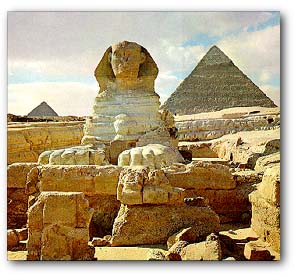| The Great Sphinx  Chephren's workers shaped the stone into the lion and gave it their king's face over
4,500 years ago. The sphinx faces the rising sun with a temple to the front which resembles the
sun temples which were built later by the kings of the 5th Dynasty. The figure was buried for
most of its life in the sand. King Thutmose IV (1425 - 1417 BC) placed a stela between the
front paws of the figure. It describes when Thutmose, while still a prince, had gone hunting and
fell asleep in the shade of the sphinx. During a dream, the sphinx spoke to Thutmose and told
him to clear away the sand because it was choking the sphinx. The sphinx told him that if he
did this, he would be rewarded with a kingship. Thutmose carried out this request and the
sphinx held up his end of the deal. Chephren's workers shaped the stone into the lion and gave it their king's face over
4,500 years ago. The sphinx faces the rising sun with a temple to the front which resembles the
sun temples which were built later by the kings of the 5th Dynasty. The figure was buried for
most of its life in the sand. King Thutmose IV (1425 - 1417 BC) placed a stela between the
front paws of the figure. It describes when Thutmose, while still a prince, had gone hunting and
fell asleep in the shade of the sphinx. During a dream, the sphinx spoke to Thutmose and told
him to clear away the sand because it was choking the sphinx. The sphinx told him that if he
did this, he would be rewarded with a kingship. Thutmose carried out this request and the
sphinx held up his end of the deal.
The sphinx is built of soft sandstone and would have disappeared long ago had it not been
buried for so long. The body is 200 feet (60m) in length and 65 feet (20m) tall. The face of the
sphinx is 13 feet (4m) wide and its eyes are 6 feet (2m) high. Part of the uraeus (sacred
cobra), the nose and the ritual beard are now missing. . The beard from the sphinx is displayed
in the British Museum. The statue is crumbling today because of the wind, humidity and the
smog from Cairo. Attempts to restore it have often caused more harm than good. No one can
be certain who the figure is to personify. It is possible that it is Chephren. If that is so, it would
then be the oldest known royal portrait in such large scale. Some say that it was built after the
pyramid of Chephren was complete. It may have been set as a sort of scarecrow to guard his
tomb. Still others say it is the face of his guardian deity, rather than Chephren himself. The
image of the sphinx is a depiction of royal power. Only a pharaoh or an animal could be
shown this way, with the animal representing a protective deity.
In the 1980's, a carefully planned restoration of the Sphinx was in progress. Over 6 years,
more than 2,000 limestone blocks were added to the body of the sphinx and chemicals were
injected. This treatment did not work. It just flaked away along with parts of the original rock.
Later, various mortars and many workers who were not trained in restoration worked for six
months to repair it. In 1988 the left shoulder crumbled and blocks fell off. Present attempts at
restoration are under the control of the Supreme Council of Antiquities' archaeologists. They
are concentrating on draining away subsoil seepage which is damaging the rock. They are also
repairing the damaged shoulder with smaller blocks and staying with the original size.
|





